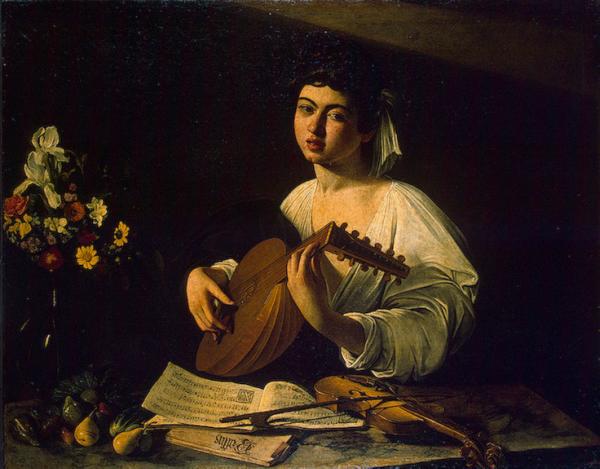Caravaggio Gallery
Oil on canvas. 94x119 cm Italy. Circa 1595
This is an early work by Caravaggio, who sought above all to convey the reality and solidity of the surrounding world. We can already see the elements of the artist's style which were to have such a widespread influence on other artists. The figure of a young boy dressed in a white shirt stands out clearly against the dark background. The sharp sidelighting and the falling shadows give the objects an almost tangible volume and weight. Caravaggio was interested in the uniqueness of the surrounding world, and there are markedly individual features not only in the youth's face but also in the objects which make up the still life: the damaged pear, the crack in the lute, the crumpled pages of the music. The melody written on those pages is that of a then fashionable song by Jacques Arcadelt, "You know that I love you". Love as the theme of this work is also indicated by other objects. For instance, the cracked lute was a metaphor for the love that fails, as in Tennyson's Idylls of the King: "It is the little rift within the lute, That by and by will make the music mute" (Merlin and Vivien).

viewer |
|
|
Lute-Player |
| Supper at Emmaus |
| David with the Head of Goliath |
| Madonna of the Rosary |
| Death of the Virgin |
| Musicians |
| Sacrifice of Isaac |
Biography
Bulletin Board
Renowned Art
(home)
Caravaggio is also known as Michelangelo Merisi and as the second Michelangelo. Caravaggio painted mostly devotional art, he focused on figures and events from the New Testament and took seriously the mundane yet monumental quality of Christianity. He used Roman street people as the model for the Apostles and Mary. He used larger than life proportions, highly theatrical lighting and crowded his significant figures into shallow spaces.
all artists, with thumbnails: by birth year | alphabetically
all artists: by birth year | alphabetically
artists born in the 13th 14th 15th 16th 17th 18th 19th 20th century